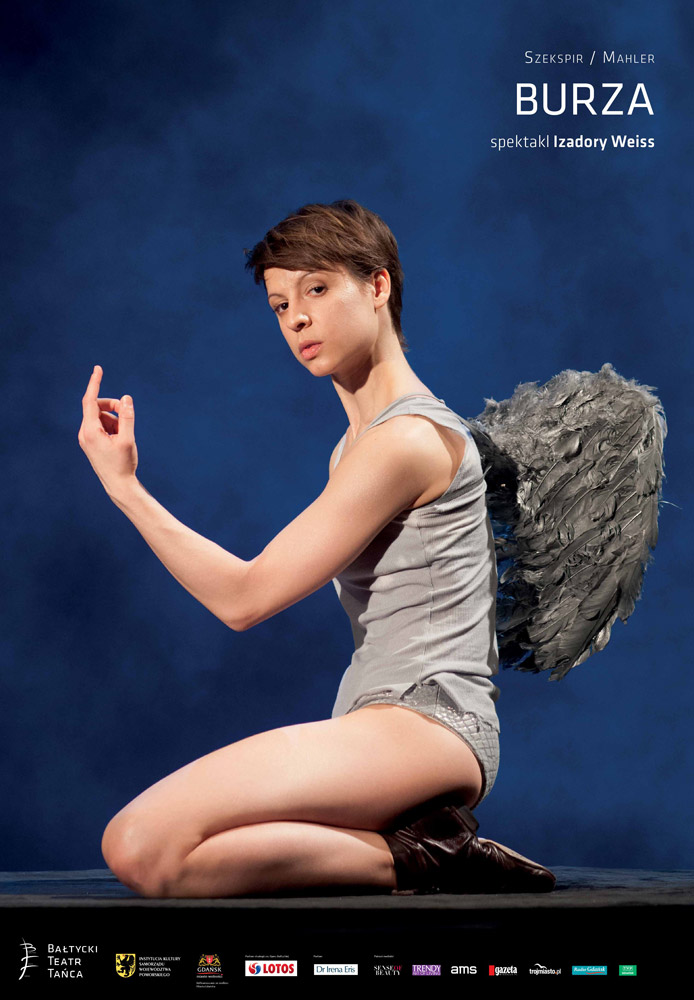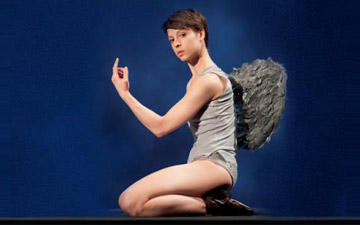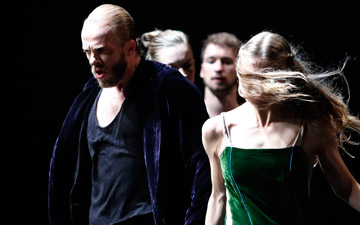
© K Mystkowski. (Click image for larger version)
Baltic Dance Theatre
Phaedra, The Tempest
Gdansk, Baltic Opera House
7 November 2015
www.baltyckiteatrtanca.pl
It seems now to be a given that any new work by Izadora Weiss will combine dramatic, narrative-based dance theatre with a profound visual impact, danced to challenging, powerful music. And the world premiere of her one-act production of Phaedra didn’t disappoint in any of these respects.
Phaedra takes the baton from Baltic Dance Theatre’s last piece, The Tempest, in a continuum that is emphasised by having this world premiere follow a performance of that previous work. And it is the music of Mahler that most embodies this mutuality in the transition between the two productions. Having taken his First symphony and extended it by the luscious adagio from the Fifth to represent The Tempest, Weiss has now turned to his final, unfinished (Tenth) symphony to help tell the anguished tale of Phaedra.
I cannot begin to imagine, frankly, the angst and furore that the idea of dancing to Mahler’s Tenth symphony would have caused amongst the conservative world of classical music a few decades ago, when such an idea would have been unthinkable. But it has proven to be an inspired choice.

© K Mystkowski. (Click image for larger version)
The music was written at a time of profound personal crisis for the ailing composer, battling the death sentence of his own failing heart and struggling with his wife’s infidelity. The score therefore has come to be seen to represent Mahler’s passionate interrogatory journey of self-psychoanalysis; Mahler believed strongly in the emerging discipline of psychology and consulted none other than Sigmund Freud during his marital breakdown.
Mahler’s music is performed here in a recording by the New York Philharmonic, conducted by Leonard Bernstein. It would – of course – have had greater impact with a live orchestra but, in this small Opera House, with a capacity of just a few hundred seats, such a luxury must be wholly unaffordable.
The Tenth symphony could have been written as the soundtrack to Jean Racine’s tragic interpretation of the Phaedra mythology. Similar moods and passions haunt the texts of both the musical and literary structures and it is to Weiss’s artistic credit that she succeeds in knitting them together in the visual splendour of a design and movement concept that is both profoundly respectful and refreshingly new. She took on the biggest challenge of her choreographic life and has made it work, stunningly.

© K Mystkowski. (Click image for larger version)
Phaedra takes place on – and around – a carpet of red petals, a deep colour palette that dominates, flowing up from the carpet and into the costumes of the corps of dancers, an ensemble that represents the ideal of a Greek chorus, more of which anon. As the curtain rises, the image of a love-making couple on the red flowers is yet another of many powerful opening statements from Weiss, the visual artist. The stage designs are those of the choreographer but it is Hanna Szymczak who has realised the costumes.
The bed of flower petals is Phaedra’s domain. From the opening sequence of that intimate embrace with her husband, Theseus, the King of Athens, she commands that arena; moving seamlessly from husband to intended lover (her stepson, Hippolytus), albeit in the mistaken belief that Theseus has died. However, Hippolytus loves Aricia (the lone survivor of the previous Royal House supplanted by Theseus), which revelation sends Phaedra into a fit of jealous rage. When Theseus returns, egged on by her nurse and confidante, Oenone, Phaedra excuses herself by declaring that Hippolytus tried to take her by force and the King banishes his son. Neptune has promised to grant Theseus his wishes and invoking this bond, Hippolytus is dashed to death by Neptune’s sea monster. Oenone also throws herself into the waves when Phaedra turns against her.

© K Mystkowski. (Click image for larger version)
With both the love of her life and her closest confidante dead and no longer trusted by her husband, who has come to believe in the innocence of Hippolytus after witnessing his tender farewell to Aricia, the performance ends with Phaedra’s suicide, drinking poison while lying on the bed of petals. Racine’s play ends with Theseus accepting Aricia as his adopted daughter, thus joining the two Royal houses together.
It’s a complex narrative and when others have tried to demonstrate it in dance, it hasn’t entirely worked. I have fond memories of Richard Alston’s production of Phaedra, to the music of Benjamin Britten, which also followed the line of the Racine play (first performed, by the way, in 1677). However, Alston’s interpretive powers were greatly enabled by having the pivotal role of Phaedra sung by a mezzo-soprano, moving as an integral player within the dance ensemble. Weiss opts to convey a detailed, albeit cut-down, version of the text in movement and expression alone and it works at any level, even without a prior knowledge of the play or the mythology Racine represents.

© K Mystkowski. (Click image for larger version)
That Weiss is successful in laying out this story as boldly as the red carpet on which it plays, is all down to her choreographic, story-telling talent, which I am increasingly coming to regard as one of a kind in the world of contemporary dance today. Weiss does romance, she does anger, jealous rage, empathy and so much more. She demonstrates emotion palpably and honestly in movement and expression such that her audience is in no doubt of her narrative intentions.
This skill is articulated in both her characterisations of individuals and relationships through the strength of solo motifs and the power and passion of her duets. But, in Phaedra, pride of place must go to her Greek Chorus, the red-dressed crew that both frames and reflects the petal-carpet. Weiss creates shapes and patterns that endure within the memory long after the performance is over, moulding the actions of these eleven dancers in the corps individually to create a flowing cascade of movement, representing the budding of a flower, the sea monster devouring Hippolytus or the waves into which Oenona dives .

© K Mystkowski. (Click image for larger version)
Two long-term members of the Baltic ensemble, Beata Giza and Filip Michalak, perform as Phaedra and Theseus. Michalak provides the gravitas and authority of one who must be obeyed. Giza is spell-binding as the scheming, blonde Queen, consumed by the obsession of illicit love and racked by the consequence of guilt and fear. Beniamin Citkowski conveys the lost, noble innocence of Hippolytus, reeled in by the arresting intentions of his step-mother: that initial compulsive look of Giza when she first sets eyes on Citkowski’s Hippolytus is as powerful as the first meeting of eyes between Romeo and Juliet, only this time it’s one-way lust. With her swept-back hair, Tura Gómez Coll is almost unrecognisable as the sweet, imprisoned Aricia.
The Tempest (premiere) was previously reviewed for DanceTabs by Jann Parry and I don’t intend to cover again here in any detail, suffice to say that this 80-minute one-act production gets better each time I see it (and I’m now at five live performances and hope for there to be many more). It’s another ingenious exemplar of narrative dance, set to challenging music, visually splendid as a masterpiece in simplistic, holistic design style. And, it benefits from towering central performances, notably by Michalak as Prospero and Gómez Coll; a tour de force as Ariel. It also showcases the longest, most shapely legs imaginable through Elźbieta Czajkowska-Kłos’s memorable, sensual walk-through cameos as Juno, a character superfluous to Shakespeare’s text.

© K. Mystkowski. (Click image for larger version)
Weiss has an intuitive skill in creating maximum impact in opening and closing her shows. The first and final few minutes of The Tempest are powerful and one reason for this is that Weiss is not frightened of stillness or of slowness and she uses moments of both to hammer home the feelings she intends to inspire. The ending of The Tempest – coming after Michalak has sat motionless on the stage for many minutes – is right up there with the strength of the ending of Kenneth MacMillan’s The Song of the Earth; and, of course, both are fuelled by the soaring music of the same composer. Music that was never meant to be danced to. Now, I doubt that there is a musical challenge that this choreographer cannot master. The next one should be interesting.
Phaedra comes to the UK for one performance only as part of a dance gala to celebrate the centenary of the British Spanish Society, which is to be held at The Place, in London, on Thursday, 26th November 2015, from 7pm. Tickets are available through the website of the British Spanish Society.
[Note: The author’s expenses were met by the Adam Mickiewicz Institute study visit program and promotion program of the City Hall of Gdansk.]

















You must be logged in to post a comment.